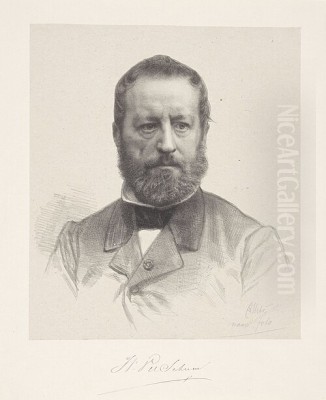
Wouterus Verschuur stands as one of the most significant animal painters of the Dutch Romantic era, celebrated particularly for his masterful depictions of horses. Born in Amsterdam on June 11, 1812, and passing away in Vorden on July 4, 1874, Verschuur dedicated his artistic life to capturing the power, grace, and character of these noble animals. His work, deeply rooted in the traditions of Dutch art yet infused with the spirit of 19th-century Romanticism, earned him considerable acclaim both within the Netherlands and internationally, securing his legacy as a preeminent figure in his chosen genre.
Early Life and Artistic Formation
Wouterus Verschuur was born into a family involved in the arts, albeit not painting; his father was a jeweler in Amsterdam. This environment may have fostered an appreciation for craftsmanship and detail from a young age. It quickly became apparent that young Wouterus possessed a remarkable talent for drawing and painting. Recognizing his potential, his family supported his artistic inclinations.
He received his formal training under the guidance of established artists Pieter Gerardus van Os (1776-1839) and Cornelis Steffelaar (1797-1861). Both were respected painters in their own right; Van Os was known for his landscapes and particularly his depictions of cattle, carrying on a family tradition of animal painting, while Steffelaar also worked in landscape and animal subjects. Under their tutelage, Verschuur honed his technical skills, learning the fundamentals of composition, color, and, crucially for his future specialization, animal anatomy.
Verschuur's prodigious talent was recognized early in his career. He began exhibiting his work while still a teenager. A significant milestone came in 1832 and again in 1833 when he was awarded gold medals at the prestigious annual exhibitions held by the Felix Meritis society in Amsterdam. This society was a hub for arts and sciences, and winning its accolades was a considerable honor that helped launch his professional career. Further cementing his place in the Dutch art establishment, he was appointed a member of the Royal Academy of Fine Arts in Amsterdam in 1833, at the young age of twenty-one.
Echoes of the Golden Age
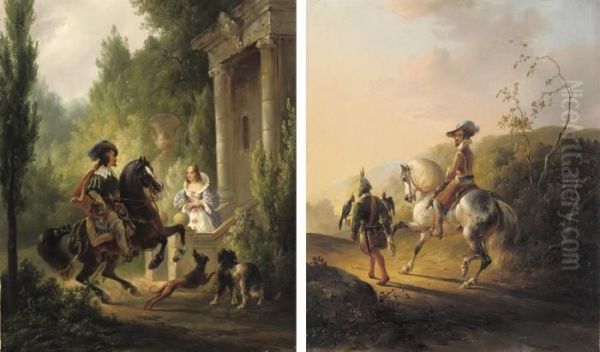
While Verschuur was undeniably a product of 19th-century Romanticism, his work resonates strongly with the legacy of the Dutch Golden Age of painting from the 17th century. He consciously looked back to the masters of that era for inspiration, particularly those renowned for their depictions of animals and daily life.
The most profound influence on Verschuur's art was undoubtedly Philips Wouwerman (1619-1668). Wouwerman was celebrated for his dynamic scenes featuring horses – cavalry skirmishes, hunting parties, stable interiors, and landscapes populated with elegant riders. Verschuur admired Wouwerman's ability to capture the horse in motion, his detailed rendering of tack and attire, his skillful compositions, and his characteristic silvery light. Many of Verschuur's own stable scenes, depictions of coaching inns, and arrangements of figures and horses clearly echo Wouwerman's compositions and thematic concerns.
Beyond Wouwerman, Verschuur likely also drew inspiration from other 17th-century Dutch masters. Paulus Potter (1625-1654), famous for his incredibly lifelike and monumental paintings of cattle and other livestock, set a high bar for realistic animal depiction that Verschuur surely noted. The luminous landscapes and tranquil pastoral scenes of Aelbert Cuyp (1620-1691), often featuring horses and cattle bathed in a warm, golden light, may also have informed Verschuur's handling of light and atmosphere in his outdoor settings. By studying these predecessors, Verschuur grounded his Romantic sensibilities in a strong Dutch artistic tradition.
The World of the Horse: Style and Subject Matter
Horses were the undisputed heart of Wouterus Verschuur's artistic universe. He dedicated his career to observing, understanding, and portraying them with unparalleled skill and sensitivity. His oeuvre encompasses a wide variety of scenes centered around the horse, reflecting its integral role in 19th-century life.
His subjects ranged from bustling stable interiors, often featuring grooms tending to their charges, to scenes outside blacksmith shops where horses were being shod. He depicted the lively atmosphere of coaching inns, with horses being harnessed or resting after a journey. Elegant riding parties, scenes of falconry (as seen in works like The Falconer), and depictions of military encampments also featured in his work. He painted working horses, sturdy and dependable, as well as sleek, thoroughbred animals, demonstrating his versatility and deep knowledge of different breeds.
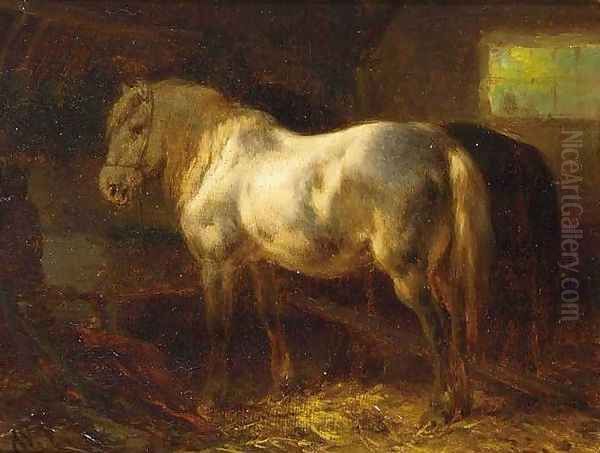
Verschuur's style is characterized by meticulous attention to detail and anatomical accuracy. He possessed an intimate understanding of equine anatomy, evident in the precise rendering of musculature, bone structure, and the characteristic sheen of a horse's coat. This realism was combined with a Romantic sensibility, emphasizing the horse's nobility, spirit, and harmonious relationship with its environment or human companions.
His compositions are typically well-balanced and carefully constructed. He was a master of light and shadow, often employing a subtle chiaroscuro to model forms and create depth, particularly in his stable interiors. The play of light filtering through a doorway or window, illuminating the flank of a horse or highlighting details of harness, is a recurring feature. His brushwork is generally fine and controlled, allowing for the detailed rendering he favored. Works like the study Horse Head, Hoof, Rump (1838) exemplify his dedication to capturing the precise form and texture of his subjects.
A Celebrated Career
Building on his early successes, Wouterus Verschuur enjoyed a long and prosperous career. He became a respected member of the Amsterdam artistic community, joining the artists' society Arti et Amicitiae, another important venue for exhibitions and professional exchange. He exhibited his work regularly not only in Amsterdam but also in The Hague and other Dutch cities, consistently receiving positive reviews and attracting patrons.
His reputation extended beyond the borders of the Netherlands. Verschuur undertook several journeys, traveling through the Dutch provinces of Gelderland and Brabant, regions known for their scenic beauty and horse breeding, which likely provided ample subject matter. He also traveled abroad, visiting parts of Switzerland, Southern Germany, and France. These travels broadened his horizons and exposed him to different landscapes and perhaps different breeds of horses, enriching his artistic repertoire.
A pinnacle of his international recognition occurred in 1855 at the Exposition Universelle (World's Fair) in Paris. This major international event showcased achievements in industry, science, and the arts. Verschuur exhibited his work there, and one of his paintings caught the eye of none other than Emperor Napoleon III of France, who purchased it for his personal collection. This imperial endorsement significantly boosted Verschuur's international standing and confirmed his status as a leading animal painter of his time. Throughout his career, his paintings were highly sought after by private collectors in the Netherlands, Britain, France, and beyond.
Verschuur in His Time: Romanticism and Peers
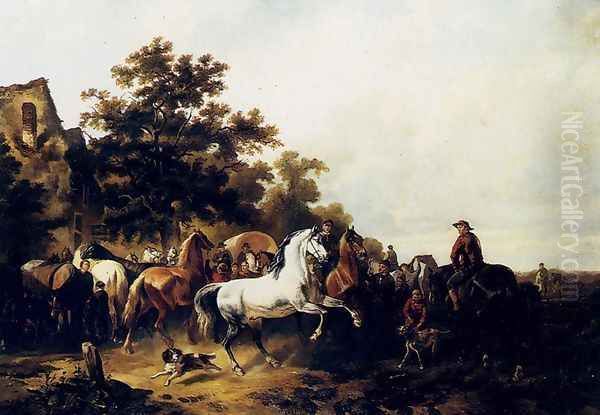
Wouterus Verschuur operated within the broader context of Dutch Romanticism, a movement that looked to the nation's Golden Age past while embracing emotional expression, individualism, and a deep appreciation for nature and history. While landscape painting was perhaps the dominant genre within Dutch Romanticism, led by figures like Barend Cornelis Koekkoek (1803-1862) and Andreas Schelfhout (1787-1870), Verschuur carved out his niche as the foremost specialist in horse painting.
His focus on horses aligned with Romantic themes of the nobility of animals and the picturesque qualities of rural life. Unlike the highly detailed, often idealized Italianate landscapes of Koekkoek or the meticulously rendered winter scenes of Schelfhout, Verschuur's work centered on the interaction between humans, animals, and their immediate environment – the stable, the inn yard, the country road.
Verschuur was not isolated within the art world. He maintained connections with his contemporaries. Notably, he occasionally collaborated with the renowned cityscape and landscape painter Cornelis Springer (1817-1891). In such collaborations, Springer would typically paint the architectural or landscape setting, while Verschuur would add the figures and, naturally, the horses, bringing the scene to life. This practice of collaboration between specialists was not uncommon during the period and highlights the mutual respect between these artists. While distinct in their primary subjects, both Verschuur and Springer shared a commitment to detailed realism and capturing the specific atmosphere of Dutch life and scenery, albeit through different lenses.
Passing the Reins: Teaching and Influence
Beyond his own prolific output, Wouterus Verschuur played an important role as an educator, passing on his knowledge and skills to the next generation of artists. He took on several pupils during his career, ensuring the continuation of the tradition of Dutch animal painting.
His most famous student was undoubtedly Anton Mauve (1838-1888). Mauve initially studied with Verschuur, absorbing his teacher's meticulous approach to animal depiction and his sensitivity to light and atmosphere. Although Mauve later developed his own distinct style, characterized by a looser brushstroke and a more melancholic, tonal palette associated with the Hague School, the foundation he received from Verschuur, particularly in drawing animals, remained crucial throughout his career. Mauve would go on to become a leading figure of the Hague School, alongside artists like Jozef Israëls (1824-1911), Jacob Maris (1837-1899), and Hendrik Willem Mesdag (1831-1915), and he also briefly mentored Vincent van Gogh.

Verschuur also taught his own son, Wouterus Verschuur Jr. (1841-1936), who followed closely in his father's footsteps, becoming a painter known for his depictions of horses and stable scenes in a style very similar to that of his father. This familial continuation of the artistic specialization further cemented the Verschuur name's association with equine art.
Verschuur's dedication to his craft is evident in the sheer volume of his output. It is estimated that he produced around 400 paintings during his lifetime. Perhaps even more astonishingly, he left behind over 20,000 drawings and sketches. This vast collection of studies underscores his relentless observation of horses in every conceivable pose and situation, forming the bedrock of his painted compositions and his profound understanding of his subject.
Final Years and Lasting Appeal
Wouterus Verschuur remained active as an artist throughout his life. He eventually settled in the town of Vorden, located in the Gelderland province, an area whose rural character likely appealed to his artistic sensibilities. It was there that he passed away on July 4, 1874, at the age of 62.
He is often regarded as one of the last major exponents of the Dutch Romantic tradition of animal painting, which had strong roots in the 17th century. The artistic tide was already turning, with the emergence of Impressionism in France and the rise of the Hague School in the Netherlands, which favored looser brushwork, plein-air painting, and often more subdued, atmospheric depictions of Dutch landscapes and peasant life.
Despite these shifts in artistic taste, Verschuur's reputation has endured. His works remain highly prized by collectors for their technical brilliance, charming subject matter, and historical significance. Major museums in the Netherlands, including the Rijksmuseum in Amsterdam and the Amsterdam Museum, as well as international institutions, hold examples of his work. His paintings continue to perform well at auction, testament to his lasting appeal among connoisseurs of 19th-century European art.
Conclusion
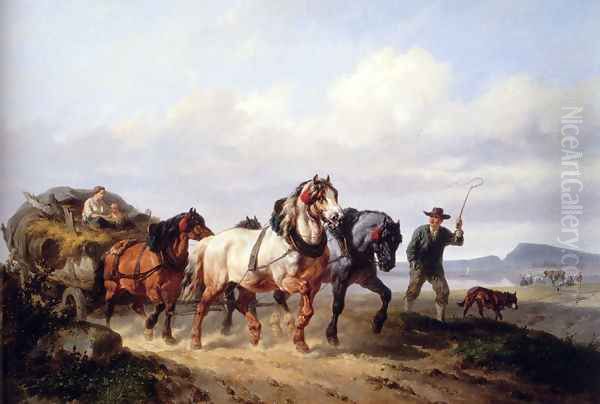
Wouterus Verschuur carved a unique and distinguished path in 19th-century Dutch art. Through his unwavering dedication to the horse, he elevated animal painting to a high art form within the Romantic tradition. Combining the meticulous observation and technical skill inherited from the Dutch Golden Age masters, particularly Philips Wouwerman, with a Romantic sensitivity to the beauty and character of his subjects, he created a body of work that is both historically significant and aesthetically pleasing. His influence extended through his teaching, most notably shaping the early career of Anton Mauve. Today, Wouterus Verschuur is remembered and celebrated as the definitive master of the horse in Dutch Romantic painting, his works continuing to captivate viewers with their detail, atmosphere, and profound appreciation for the equine world.